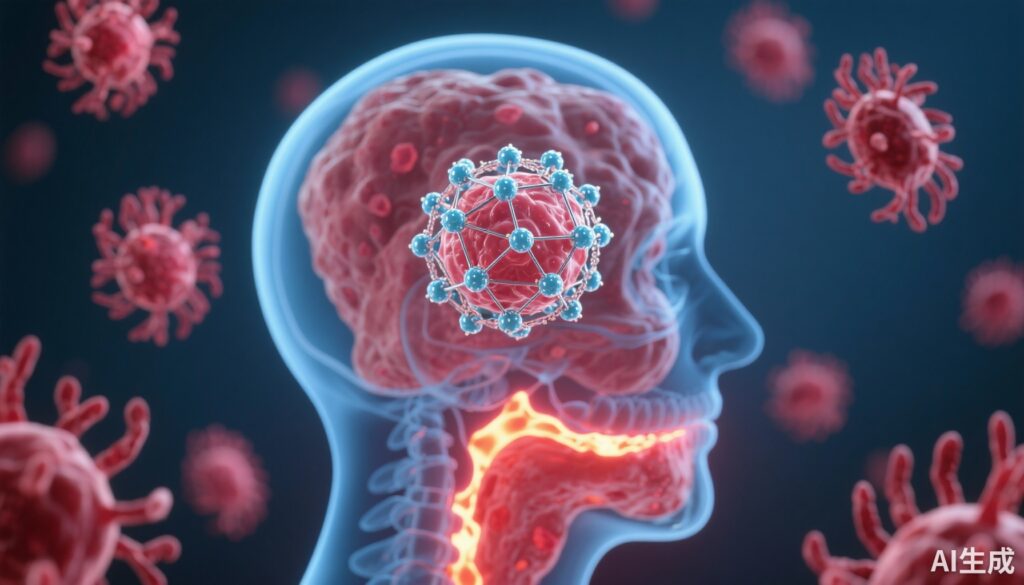Highlight
– Development of Biotin@P-Cur/T780 nanoplatform combines a polymeric curcumin prodrug with a photothermal agent for targeted therapy.
– The platform targets head and neck cancer stemness, overcoming resistance by inducing apoptosis and ferroptosis.
– Synergistic photothermal and photodynamic therapy amplifies immunogenic cell death and reprograms the tumor microenvironment.
– This multimodal approach effectively suppresses tumor growth, metastasis, and enhances immune responses in preclinical models.
Study Background and Disease Burden
Head and neck cancer (HNC) represents a significant oncologic challenge with high morbidity and mortality worldwide. Despite advances in surgery, radiation, chemotherapy, and more recently immunotherapy, outcomes remain suboptimal. Immunotherapy, particularly immune checkpoint blockade, has revolutionized cancer treatment but frequently achieves limited efficacy in HNC due to two critical resistance factors: tumor cell stemness and immunosuppressive tumor microenvironment (TME).
Tumor cell stemness contributes to therapeutic resistance and tumor recurrence by sustaining a subset of cells with self-renewal and differentiation ability. These cancer stem cells (CSCs) evade immune surveillance, enhance tumor heterogeneity, and drive metastasis. Simultaneously, an immunosuppressive TME, characterized by dysfunctional dendritic cells and reduced cytotoxic T cell infiltration, further impairs antitumor immunity. Thus, strategies capable of simultaneously eradicating CSCs and reprogramming the TME toward an immunostimulatory state constitute a pressing unmet need in HNC therapy.
Study Design
The study by Shen et al. introduces a novel tumor-targeted polymer prodrug nanoplatform, designated Biotin@P-Cur/T780 nanoparticles (NPs), designed to overcome HNC resistance mechanisms. This multifunctional nanoplatform integrates:
– Polycurcumin (P-Cur) linked via disulfide bonds capable of intracellular glutathione (GSH)-triggered release.
– T780, a near-infrared (NIR) photothermal agent, enabling photothermal therapy (PTT) and photodynamic therapy (PDT).
– Surface functionalization with DSPE-PEG-Biotin for active tumor targeting exploiting biotin receptor overexpression on HNC cells.
The NPs leverage tumor-specific high GSH to induce nanoplatform disassembly, releasing active curcumin monomers and T780. Curcumin induces dual GSH depletion and amplifies reactive oxygen species (ROS), triggering apoptosis and ferroptosis. Concurrent NIR irradiation activates T780, combining PTT/PDT to promote immunogenic cell death (ICD) and enhance antitumor immune responses. The study evaluates efficacy through in vitro assays on HNC stem-like cells and in vivo murine HNC tumor models, assessing tumor growth, metastasis, immune cell activation, and survival.
Key Findings
The Biotin@P-Cur/T780 nanoplatform demonstrated potent antitumor activity stemming from multimodal mechanisms:
1. Suppression of Tumor Stemness: The nanoplatform effectively decreased HNC stemness markers and populations in vitro and in vivo, implicating direct targeting and eradication of cancer stem cells responsible for recurrence and resistance.
2. Induction of Dual Apoptosis and Ferroptosis: Curcumin-induced GSH depletion and elevated ROS induced apoptotic pathways and ferroptosis, a form of regulated cell death dependent on iron and lipid peroxidation. This dual mechanism proved efficient in eliminating resistant cancer cells.
3. Photothermal and Photodynamic Therapy Synergy: NIR activation of T780 enhanced ROS generation and localized hyperthermia, intensifying ICD. This leads to robust dendritic cell maturation and subsequent activation of cytotoxic T lymphocytes, reversing the immunosuppressive TME.
4. Immunomodulation and Tumor Microenvironment Reprogramming: Enhanced ICD drove a shift toward an immunostimulatory milieu, marked by increased dendritic cell activation and T cell infiltration, crucial for sustained antitumor immune responses.
5. Efficacy in Tumor Models: In HNC murine models, treatment with Biotin@P-Cur/T780 NPs significantly inhibited primary tumor growth and distant metastasis, also prolonging survival without notable toxicity.
These findings establish the nanoplatform’s multimodal therapeutic superiority, addressing two major hurdles in HNC immunotherapy—stemness-driven resistance and TME-mediated immunosuppression.
Expert Commentary
The integration of curcumin, a natural polyphenol with known anticancer and anti-inflammatory properties, within a polymer prodrug design provides stability, targeted delivery, and controlled release, overcoming limitations of free curcumin such as poor bioavailability. Importantly, the GSH-responsive disulfide linkage exploits the redox imbalance characteristic of tumors, ensuring selective cytotoxicity.
Combining PTT and PDT through T780 activation represents an innovative approach to amplify oxidative stress and immune activation synergistically. The resulting ICD is critical for the success of immunotherapies by exposing tumor antigens and activating dendritic cells, promoting adaptive immunity.
Notwithstanding the promising preclinical results, clinical translation will require addressing potential challenges such as NIR penetration depth limitations in human tumors, long-term nanoparticle safety profiles, and heterogeneity of biotin receptor expression.
Overall, this study validates a rational and versatile nanoplatform design addressing fundamental biological barriers in HNC treatment and highlights the necessity of combinatorial approaches acting on both tumor cells and their microenvironment to enhance immunotherapeutic outcomes.
Conclusion
The curcumin-based polymer prodrug nanoplatform Biotin@P-Cur/T780 NPs emerges as a potent combinatorial strategy that targets head and neck cancer cell stemness and remodels the immunosuppressive tumor microenvironment. By inducing dual apoptosis and ferroptosis alongside photothermal/photodynamic therapy-enhanced immunogenic cell death, this platform overcomes intrinsic resistance mechanisms and substantially improves antitumor immunity and therapeutic efficacy. The findings underscore the translational potential of such multifunctional nanomedicines in refractory malignancies and invite further clinical investigation to optimize integration with existing immunotherapy regimens.
References
1. Shen Z, Jiang H, Lu S, Tian H, Gao F, Deng H, Huang C. Curcumin-based polymer prodrug nanoplatform for high-efficiency immunotherapy by synergistically suppression of head and neck cancer cell stemness. J Nanobiotechnology. 2025 Jul 11;23(1):500. doi: 10.1186/s12951-025-03559-9. PMID: 40646575; PMCID: PMC12247197.
2. Chen DS, Mellman I. Elements of cancer immunity and the cancer–immune set point. Nature. 2017;541(7637):321-330.
3. Noman MZ, Janji B, Berchem G, et al. Immune checkpoint blockade: new insights and opportunities for cancer immunotherapy. J Hematol Oncol. 2017;10(1):108.
4. Wang W, Green M, Choi JE, et al. CD8+ T cells regulate tumour ferroptosis during cancer immunotherapy. Nature. 2019;569(7755):270-274.
5. Liang C, Pu K. Activatable Polymer Nanoenzymes for Synergistic Cancer Therapy. ACS Nano. 2020;14(12):17821-17824.



